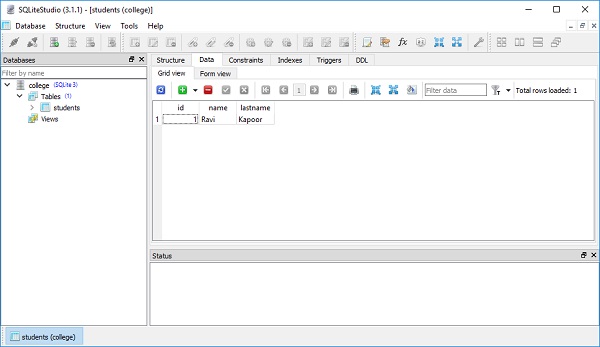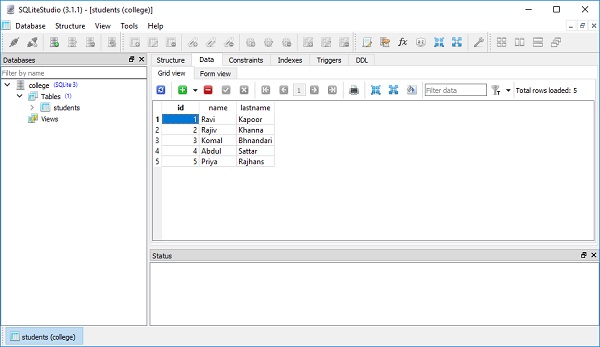
- SQLAlchemy Tutorial
- SQLAlchemy - Home
- SQLAlchemy - Introduction
- SQLAlchemy Core
- Expression Language
- Connecting to Database
- Creating Table
- SQL Expressions
- Executing Expression
- Selecting Rows
- Using Textual SQL
- Using Aliases
- Using UPDATE Expression
- Using DELETE Expression
- Using Multiple Tables
- Using Multiple Table Updates
- Parameter-Ordered Updates
- Multiple Table Deletes
- Using Joins
- Using Conjunctions
- Using Functions
- Using Set Operations
- SQLAlchemy ORM
- Declaring Mapping
- Creating Session
- Adding Objects
- Using Query
- Updating Objects
- Applying Filter
- Filter Operators
- Returning List and Scalars
- Textual SQL
- Building Relationship
- Working with Related Objects
- Working with Joins
- Common Relationship Operators
- Eager Loading
- Deleting Related Objects
- Many to Many Relationships
- Dialects
- SQLAlchemy Useful Resources
- SQLAlchemy - Quick Guide
- SQLAlchemy - Useful Resources
- SQLAlchemy - Discussion
SQLAlchemy Core - Executing Expression
In the previous chapter, we have learnt SQL Expressions. In this chapter, we shall look into the execution of these expressions.
In order to execute the resulting SQL expressions, we have to obtain a connection object representing an actively checked out DBAPI connection resource and then feed the expression object as shown in the code below.
conn = engine.connect()
The following insert() object can be used for execute() method −
ins = students.insert().values(name = 'Ravi', lastname = 'Kapoor') result = conn.execute(ins)
The console shows the result of execution of SQL expression as below −
INSERT INTO students (name, lastname) VALUES (?, ?)
('Ravi', 'Kapoor')
COMMIT
Following is the entire snippet that shows the execution of INSERT query using SQLAlchemy’s core technique −
from sqlalchemy import create_engine, MetaData, Table, Column, Integer, String
engine = create_engine('sqlite:///college.db', echo = True)
meta = MetaData()
students = Table(
'students', meta,
Column('id', Integer, primary_key = True),
Column('name', String),
Column('lastname', String),
)
ins = students.insert()
ins = students.insert().values(name = 'Ravi', lastname = 'Kapoor')
conn = engine.connect()
result = conn.execute(ins)
The result can be verified by opening the database using SQLite Studio as shown in the below screenshot −

The result variable is known as a ResultProxy object. It is analogous to the DBAPI cursor object. We can acquire information about the primary key values which were generated from our statement using ResultProxy.inserted_primary_key as shown below −
result.inserted_primary_key [1]
To issue many inserts using DBAPI’s execute many() method, we can send in a list of dictionaries each containing a distinct set of parameters to be inserted.
conn.execute(students.insert(), [
{'name':'Rajiv', 'lastname' : 'Khanna'},
{'name':'Komal','lastname' : 'Bhandari'},
{'name':'Abdul','lastname' : 'Sattar'},
{'name':'Priya','lastname' : 'Rajhans'},
])
This is reflected in the data view of the table as shown in the following figure −

To Continue Learning Please Login